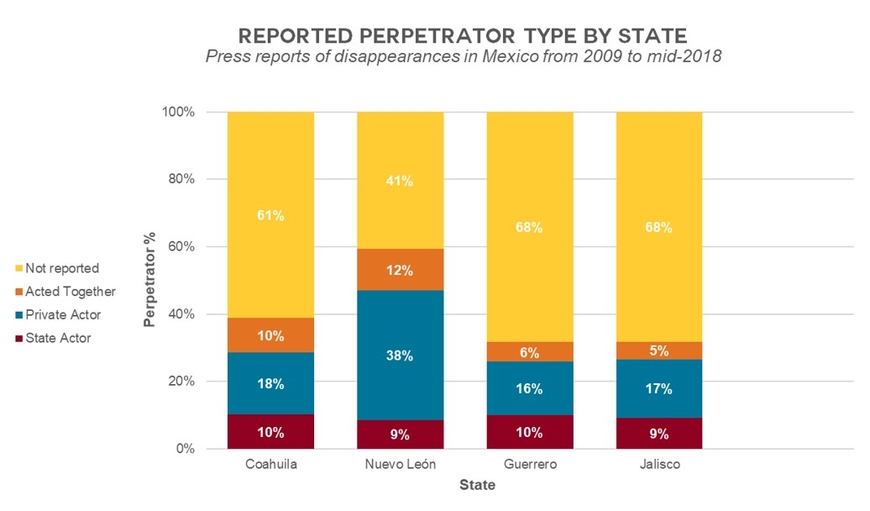What Was Reported About the Perpetrators?
In 4 out of 10 disappearance cases in these four states (41%), the press reported information about the suspected perpetrators. The level of detail reported varied. In some cases, the press named a specific group responsible (e.g. cartel or government department) and in others, unspecific individuals (e.g. private persons or unidentified state actors).
Our interviews with journalists confirmed that, for security reasons, they or their editors often chose not to name a specific criminal group in their reporting (Frey and Cuellar 2020). One journalist explained, “Yes, we stopped signing our articles, and then there was a moment when we stopped including the names of cartels, for example, Los Zetas, the Gulf cartel, only writing ‘a criminal group.’” (Reporter 3, interviewed by Olga Salazar Pozos, June 19, 2019).
We analyzed information about the perpetrators in our database both by type of actor (state versus private actor) and by category (specific group affiliation). Perpetrators were grouped into three categories: state actors, private actors (including criminal organizations), and state and private actor collusion. In the database, approximately half of the private actors were associated with a specific criminal organization, and half were not identified as affiliated with a specific group (e.g. described generally as armed groups or kidnappers).
When perpetrators were named in disappearance cases, the press identified the perpetrators as state actors in nearly a fourth of disappearances (23%), private actors in more than half (55%), and both state and private actors colluding together in about a fifth (21%) of the cases. In the two northern states, Coahuila and Nuevo León, there were higher reported incidences of state and private actor collusion (see fig. 7). The involvement of state actors reported as perpetrators—whether acting on their own or in collusion with private actors—was highest in Guerrero. The role of criminal organizations acting alone was most pronounced in reporting from Nuevo León. As shown in Figure 7, press reports on disappearances in Nuevo León identified a suspected perpetrator at a higher frequency than the other states, as well as reporting a higher percentage of private actor involvement.

The specific criminal organization, when reported in the disappearance cases, differed by region (see fig. 8). In the northern states, Coahuila and Nuevo León, the press reported that Los Zetas committed the highest number of disappearances. This is consistent with previous reporting by the Observatory. In Jalisco, Cartel de Nueva Generacion was reported most frequently. Press reports in Guerrero rarely identified nor named private actors as the perpetrators.



